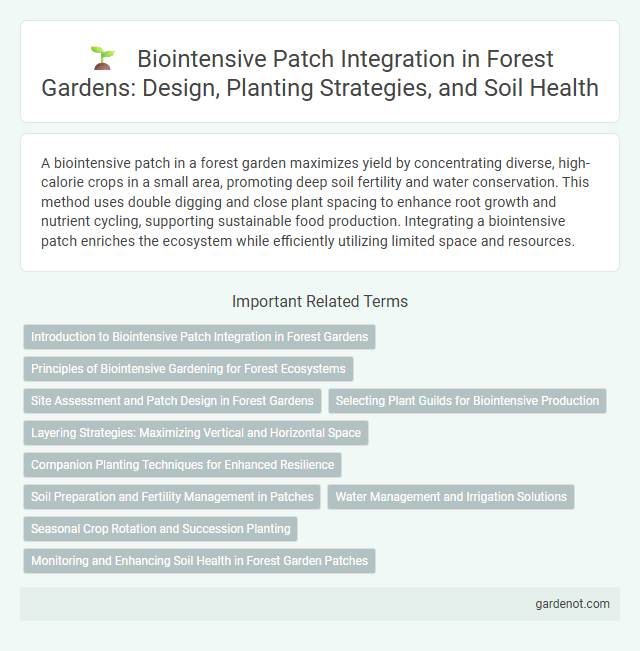A biointensive patch in a forest garden maximizes yield by concentrating diverse, high-calorie crops in a small area, promoting deep soil fertility and water conservation. This method uses double digging and close plant spacing to enhance root growth and nutrient cycling, supporting sustainable food production. Integrating a biointensive patch enriches the ecosystem while efficiently utilizing limited space and resources.
Introduction to Biointensive Patch Integration in Forest Gardens
Biointensive patch integration in forest gardens enhances soil fertility and biodiversity by combining deep-rooted plants with nutrient-accumulating species. This method optimizes space through dense planting and composting, resulting in increased organic matter and improved water retention. Incorporating biointensive patches supports sustainable food production and resilient ecosystem functions within forest garden systems.
Principles of Biointensive Gardening for Forest Ecosystems
Biointensive gardening maximizes biodiversity and soil health through double-digging, composting, and companion planting within forest ecosystems. This method emphasizes minimal soil disturbance, deep root systems for aeration, and organic matter enhancement to sustain nutrient cycling. Integrating native forest plants supports symbiotic relationships, fostering resilient and productive garden patches.
Site Assessment and Patch Design in Forest Gardens
Biointensive patch design in forest gardens maximizes productivity by analyzing soil quality, microclimate, and sunlight exposure during site assessment. Incorporating deep soil preparation and companion planting enhances nutrient cycling and water retention within the patch. Strategic spatial arrangement supports biodiversity, pest management, and sustainable growth in diverse agroforestry systems.
Selecting Plant Guilds for Biointensive Production
Selecting plant guilds for biointensive production emphasizes complementary species that maximize space, nutrient cycling, and pest management within a confined area. Key guilds incorporate nitrogen-fixers like legumes, dynamic accumulators such as comfrey, and deep-rooted plants to enhance soil fertility and structure. Strategic layering of fruit trees, shrubs, herbs, and groundcovers optimizes sunlight capture and biodiversity for sustained productivity in forest gardens.
Layering Strategies: Maximizing Vertical and Horizontal Space
Biointensive patch design employs layering strategies to maximize vertical and horizontal space by integrating multiple crop layers such as canopy trees, shrubs, herbaceous plants, ground covers, root crops, and vines. This approach enhances biodiversity, improves soil health, and increases overall productivity by mimicking natural forest garden ecosystems. Efficient spatial arrangement in biointensive systems optimizes light absorption, nutrient cycling, and water retention, leading to sustainable and high-yield food production.
Companion Planting Techniques for Enhanced Resilience
Biointensive patches utilize companion planting techniques to maximize space, improve soil fertility, and boost pest resistance in forest gardens. Strategic pairing of plants such as legumes with leafy greens enhances nitrogen fixation and creates microclimates that support diverse crop growth. This method increases ecological resilience by promoting biodiversity, reducing the need for chemical inputs, and improving overall garden productivity.
Soil Preparation and Fertility Management in Patches
Biointensive patches in forest gardens focus on deep soil preparation through double digging to enhance aeration and root penetration, increasing microbial activity essential for nutrient cycling. Fertility management incorporates compost, green manures, and biochar to improve organic matter content and maintain balanced soil nutrients, promoting robust plant growth. Regular soil testing ensures optimal pH and nutrient levels, enabling precise amendment adjustments to sustain long-term soil health and productivity.
Water Management and Irrigation Solutions
Biointensive patches in forest gardens utilize water management techniques such as deep soil preparation and mulching to maximize moisture retention and minimize evaporation. Irrigation solutions often include drip systems and hand watering focused on root zones, ensuring efficient water use without oversaturation. These methods promote sustainable hydration, supporting dense planting and healthy plant growth with minimal water waste.
Seasonal Crop Rotation and Succession Planting
Biointensive patches maximize soil fertility and yield by employing seasonal crop rotation, which reduces pest buildup and nutrient depletion through alternating deep-rooted and shallow-rooted plants. Succession planting within these patches ensures continuous harvests by staggering crop maturity times, maintaining consistent production throughout growing seasons. Integrating legumes enhances nitrogen fixation, supporting sustainable nutrient cycling in the forest garden ecosystem.
Monitoring and Enhancing Soil Health in Forest Garden Patches
Biointensive patches in forest gardens require regular monitoring of soil pH, moisture levels, and nutrient content to maintain optimal growing conditions. Implementing soil amendments such as compost, biochar, and organic mulches enriches microbial activity and enhances soil structure. Consistent soil testing and adaptive management improve plant health, increase yields, and support sustainable ecosystem functions.
Biointensive patch Infographic

 gardenot.com
gardenot.com